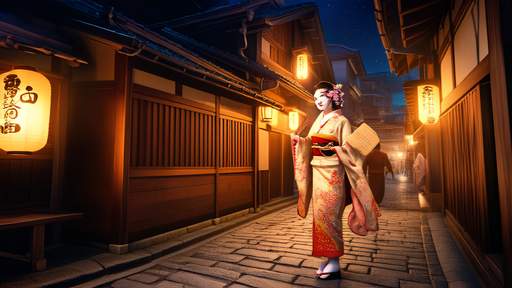The narrow, lantern-lit streets of Kyoto’s Gion district have long been synonymous with the enigmatic world of geisha and maiko. Among these historic lanes, Hanamikoji Street stands out as the beating heart of this cultural microcosm. Here, the delicate shuffle of wooden geta sandals against cobblestones signals the passage of these iconic figures, their movements as carefully choreographed as the dances they perform. To witness their daily trajectories is to glimpse a vanishing tradition that persists against the tide of modernity.
The rhythm of Hanamikoji Street is dictated by an unspoken schedule, one that has remained largely unchanged for centuries. As dusk settles over Kyoto, the wooden teahouses and ochaya (exclusive establishments where geisha entertain) begin to stir. The maiko, apprentice geisha, are often the first to emerge, their vibrant kimonos and elaborate hairstyles setting them apart from their more subdued senior counterparts. Their movements are purposeful—a swift glide from one appointment to the next, with little time for distraction. Locals and seasoned visitors know to step aside, allowing these young women to pass unimpeded.
What few outsiders realize is the sheer precision behind these seemingly casual journeys. Every turn down a side alley, every pause at a particular teahouse, is part of a meticulously planned route. The geisha and maiko of Gion operate within a tightly knit network, their schedules coordinated to ensure they can attend multiple engagements in a single evening. This logistical ballet is managed by their okiya (geisha houses), where veteran geisha and house mothers oversee the intricate web of appointments and obligations.
The interplay between public spectacle and private tradition is particularly striking along Hanamikoji. While tourists cluster at the intersection of Shijo Street, hoping to snap photos of passing maiko, the women themselves often divert to lesser-known pathways. These detours aren’t merely for privacy—they’re a nod to the district’s historical layout, where certain alleys were designed to provide discreet access between teahouses. To walk these backstreets is to trace the invisible threads connecting Gion’s cultural landmarks.
Seasonal shifts bring subtle changes to these daily patterns. In spring, the maiko’s routes might include stops at cherry blossom-viewing parties, their pink and white kimono sleeves blending with the falling petals. Summer sees them fanning themselves languidly between engagements, the heat making their layered costumes a test of endurance. Autumn’s crisp air brings a resurgence of energy, while winter transforms their movements into a careful negotiation of icy patches beneath snow-dusted eaves. Each season imposes its own tempo, yet the underlying structure remains unshaken.
The relationship between these performers and their environment is profoundly symbiotic. The wooden machiya townhouses with their latticed windows aren’t just backdrop—they’re active participants in the geisha world. Certain establishments have hosted generations of artists, their walls absorbing decades of music and murmured conversation. When a maiko pauses to adjust her obi sash or check the time on a discreet wristwatch (a rare modern concession), she does so in the shadow of buildings that have witnessed countless such moments before.
Technology has introduced quiet disruptions to these age-old patterns. Where once a house assistant might have run messages between teahouses, smartphones now handle last-minute scheduling changes. Some okiya employ drivers to whisk their charges between distant appointments, though the core of Gion remains navigated on foot. The most traditional houses still resist these innovations, believing that the physical act of moving through the streets—being seen and recognized—is as vital to a geisha’s craft as her musical or dance training.
For visitors hoping to understand this living tradition, patience proves more valuable than persistence. The geisha’s world operates on its own timetable, one that rarely aligns with tourist expectations. Those who linger near the quieter ends of Hanamikoji at twilight, rather than jostling for photos at its busier intersections, might catch a fleeting glimpse of white-faced figures disappearing through sliding doors—a momentary breach between the modern world and one that continues to move to its own timeless rhythm.
The preservation of these movement patterns speaks to Gion’s larger struggle to maintain its identity. As Kyoto’s tourist numbers swell and global influences seep into its ancient streets, the geisha’s daily trajectories become acts of cultural defiance. Each measured step along the flagstones reinforces a system of values that prioritizes artistry over convenience, tradition over accessibility. In a city increasingly defined by change, the sight of a maiko hurrying to her next performance offers reassurance that some rhythms still endure.

By /Jun 5, 2025

By /Jun 5, 2025

By /Jun 5, 2025

By /Jun 5, 2025

By /Jun 5, 2025

By /Jun 5, 2025

By /Jun 5, 2025

By /Jun 5, 2025

By /Jun 5, 2025

By /Jun 5, 2025

By /Jun 5, 2025

By /Jun 5, 2025

By /Jun 5, 2025

By /Jun 5, 2025

By /Jun 5, 2025

By /Jun 5, 2025

By /Jun 5, 2025

By /Jun 5, 2025

By /Jun 5, 2025

By /Jun 5, 2025